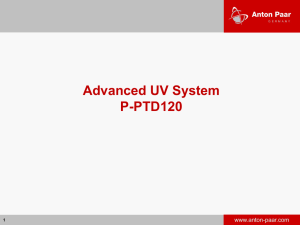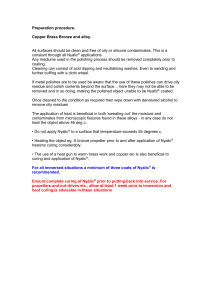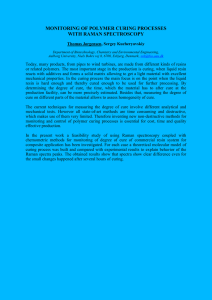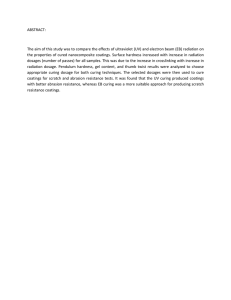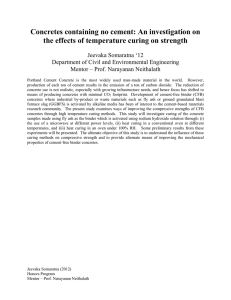cure monitoring of composites by dea
advertisement
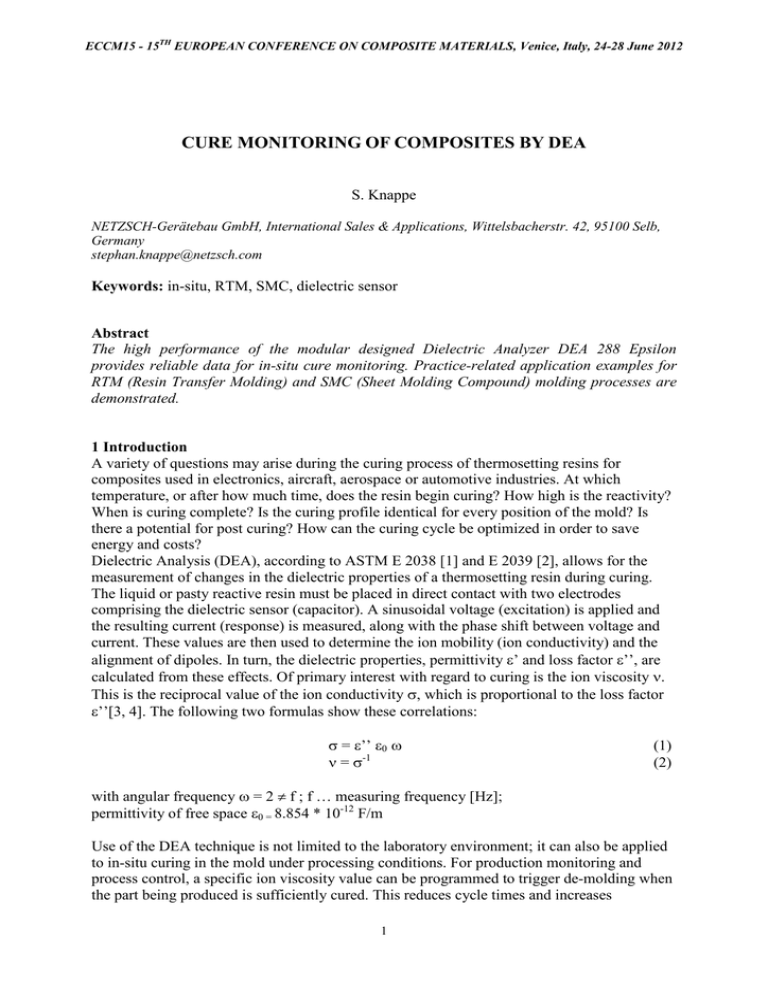
ECCM15 - 15TH EUROPEAN CONFERENCE ON COMPOSITE MATERIALS, Venice, Italy, 24-28 June 2012 CURE MONITORING OF COMPOSITES BY DEA S. Knappe NETZSCH-Gerätebau GmbH, International Sales & Applications, Wittelsbacherstr. 42, 95100 Selb, Germany stephan.knappe@netzsch.com Keywords: in-situ, RTM, SMC, dielectric sensor Abstract The high performance of the modular designed Dielectric Analyzer DEA 288 Epsilon provides reliable data for in-situ cure monitoring. Practice-related application examples for RTM (Resin Transfer Molding) and SMC (Sheet Molding Compound) molding processes are demonstrated. 1 Introduction A variety of questions may arise during the curing process of thermosetting resins for composites used in electronics, aircraft, aerospace or automotive industries. At which temperature, or after how much time, does the resin begin curing? How high is the reactivity? When is curing complete? Is the curing profile identical for every position of the mold? Is there a potential for post curing? How can the curing cycle be optimized in order to save energy and costs? Dielectric Analysis (DEA), according to ASTM E 2038 [1] and E 2039 [2], allows for the measurement of changes in the dielectric properties of a thermosetting resin during curing. The liquid or pasty reactive resin must be placed in direct contact with two electrodes comprising the dielectric sensor (capacitor). A sinusoidal voltage (excitation) is applied and the resulting current (response) is measured, along with the phase shift between voltage and current. These values are then used to determine the ion mobility (ion conductivity) and the alignment of dipoles. In turn, the dielectric properties, permittivity ε’ and loss factor ε’’, are calculated from these effects. Of primary interest with regard to curing is the ion viscosity ν. This is the reciprocal value of the ion conductivity σ, which is proportional to the loss factor ε’’[3, 4]. The following two formulas show these correlations: σ = ε’’ ε0 ω ν = σ-1 (1) (2) with angular frequency ω = 2 π f ; f … measuring frequency [Hz]; permittivity of free space ε0 = 8.854 * 10-12 F/m Use of the DEA technique is not limited to the laboratory environment; it can also be applied to in-situ curing in the mold under processing conditions. For production monitoring and process control, a specific ion viscosity value can be programmed to trigger de-molding when the part being produced is sufficiently cured. This reduces cycle times and increases 1 ECCM15 - 15TH EUROPEAN CONFERENCE ON COMPOSITE MATERIALS, Venice, Italy, 24-28 June 2012 throughput, thereby lowering costs and potentially allowing lower prices to be charged for the finished part. 2 Instrumentation and sensor types The modular concept of the new DEA 288 Epsilon (figure 1) allows for the study of the curing behavior of thermosetting resins in composites. Each DEA 288 instrument consists of a power supply including connectors for different cooling devices and a main unit with digital and analog inputs and outputs, USB connector to PC, slot for SD card and a connector to an oven or a press. The various industrial versions of the DEA 288 Epsilon offer slots for up to 2, 8 or even 16 DEA modules (channels). Each DEA module provides for both DEA signal (via sensor connector) and temperature (by various thermocouples or RTDs). Further on a socket for additional digital input/output or analog output is available. Figure 1: DEA 288 Epsilon - industrial version for up to 8 DEA modules (channels) The industrial versions are intended for production monitoring and process control. Up to 16 channels are available for simultaneous multi-channel cure monitoring by using multifrequency scans per each channel. The frequency range amounts from 1 mHz to 1 MHz. High frequencies (e.g. 10 kHz) are preferred to measure the flow front of the liquid resin at different positions (DEA channels) in the mold. Short data acquisition times of <5ms allow for very fast detection of the dielectric changes. Low frequencies (e.g. 0.1 Hz) are ideal to monitor the final end of curing or to detect post curing effects. All industrial devices are connected via rugged extension cables and connectors to various sensor types which are located in molds, presses, ovens or autoclaves. Reusable tool mount sensors (TMS, figure 2) and so-called monotrode sensors in a variety of geometries and temperature/pressure ranges can be successfully applied to molding processes such as RTM (Resin Transfer Molding) or SMC (Sheet Molding Compound). Figure 2: Reusable TMS comb sensor for the mold of the RTM process 2 ECCM15 - 15TH EUROPEAN CONFERENCE ON COMPOSITE MATERIALS, Venice, Italy, 24-28 June 2012 Various implantable (disposable) comb sensors can be positioned between the different layers of glass fibers or carbon fibers and provide the curing profile in the direction of the part thickness (z axis). For composites with electrically conductive carbon fibers, the sensors must be protected to avoid a short circuit. The disposable IDEX (interdigitated electrode) sensors have a glass-fiber cloth which allows the liquid resin to penetrate while still preventing contact with the carbon fiber. The reusable TMS or monotrode sensors are protected by a resistant SiO2 glass coating. 3 Cure monitoring of a CFRP automotive part during RTM Figure 3 depicts the curing of a liquid epoxy resin used for a carbon fiber-reinforced plastic (CFRP) automotive part at a mold temperature of 80°C. A filtered IDEX sensor was positioned between two carbon fiber layers. The measuring frequency amounted to 10 Hz. Initially, ion viscosity drops due to the increase in temperature from RT to 80°C. This minimum value after 38 s represents the lowest viscosity and therefore the best flow behavior. Curing begins immediately thereafter, with an increase of ion viscosity of more than four orders of magnitude after approximately 150 s. The gradient of this high increase correlates with the high reactivity of the resin (curing speed). After 258 s (extrapolated onset), a small second curing step is detected. After approximately 360 s, the ion viscosity curve levels out, signaling that curing is practically completed and that the cured CFRP part can be safely demolded at this time. Figure 3: Ion viscosity for the curing of a CFRP part during RTM at a mold temperature of 80°C 4 Cure monitoring of SMC parts at different temperatures In figure 4 the curing of three glass fiber-reinforced polyester SMC parts is displayed for three different mold temperatures. A 1” monotrode sensor was implemented in the bottom mold with the top mold being used as the second electrode. The measuring frequency amounted to 1000 Hz. The highest temperature of 150°C (red curves) provides the deepest drop of ion viscosity after 68 s followed by the fastest curing of approximately 1.5 orders of magnitude within the shortest curing time. After approximately 300 s the ion viscosity levels out signifying that curing is completed. At moderate press temperature of 135°C (blue curves) curing is slower and starts only after 145 s. Curing is completed here after approximately 600 s. The lowest mold temperature of only 120°C shows that curing only starts after 334 s with a lower slope 3 ECCM15 - 15TH EUROPEAN CONFERENCE ON COMPOSITE MATERIALS, Venice, Italy, 24-28 June 2012 (lower reactivity). Here, curing is not even completed after 1000 s which can be easily seen in a still increasing ion viscosity. Figure 4: Ion viscosity for the curing of SMC parts at three different mold temperatures 5 Concluding comments The high performance of the modular designed DEA 288 Epsilon provides reliable data for in-situ cure monitoring for RTM (Resin Transfer Molding) and SMC (Sheet Molding Compound) molding processes. The examples in figures 3 and 4 clearly demonstrate cure monitoring of thermosetting resins by Dielectric Analysis (DEA) in practice. References [1] ASTM E 2038. Standard Test Method for Temperature Calibration of Dielectric Analyzers, 1999 (Reapproved 2004). [2] ASTM E 2039. Standard Practice for Determining and Reporting Dynamic Dielectric Properties, 2004. [3] Knappe, S. Following cross-linking. Farbe + Lack, 9/2003. [4] Knappe, S. Even in-situ. Paint & Coatings Industry, 9/2005. 4
